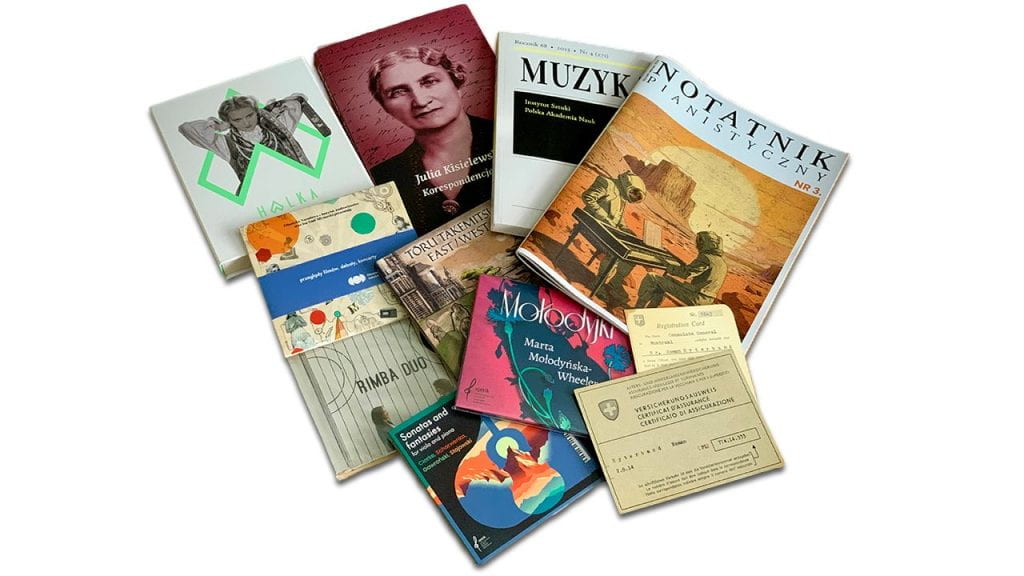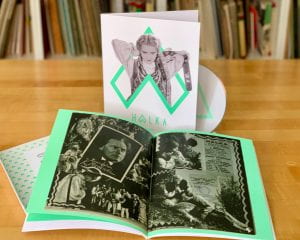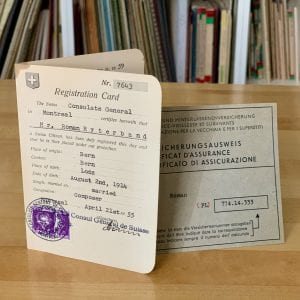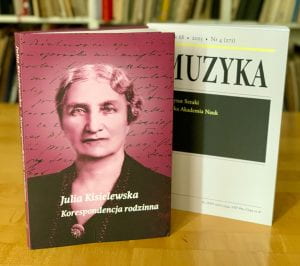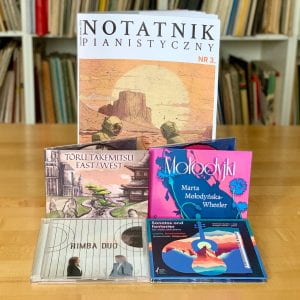Two Treasures from the National Film Archives
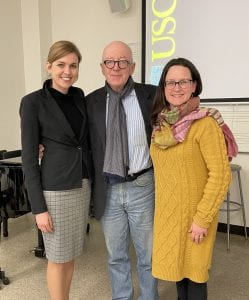
During her recent PMC visit, Dr. Dorota Lekka, Head of the International Department of the National Film Archive – Audiovisual Institute (pictured at left with PMC Director Marek Zebrowski and Assistant Director Krysta Close), donated to us two fascinating items: a DVD of Stanisław Moniuszko’s opera Halka, and a 2-CD set of Polish popular music. The CD set features a medley of songs spanning well over a century written by such composers as Henryk Wars, Victor Young, Alfred Schütz, or Fanny Gordon to lyrics by Marian Hemar, Feliks Konarski, Ludwik Starski and Julian Tuwim. With performers such as Jan Emil Młynarski, Bohdan Łazuka, and Kuba Stankiewicz, and ensembles such as Warszawskie Combo Taneczne or Mała Orkiestra Dansingowa Noama Zylberga, this CD set surveys a great deal of music that Polish audiences have enjoyed both in live performances and radio broadcasts for many decades. With this gift added to our audio library, students and researchers of Polish popular music will have another interesting item to explore.
The other gift to the PMC library from Dr. Lekka, the DVD of Stanisław Moniuszko’s Halka, is a very rare treat indeed. It comes in an attractive box with extensive liner notes in Polish and English. This DVD features a remastered copy of the 1929 and 1932 film versions of one of Moniuszko’s best-known operas.
Premiered in Warsaw in 1858, Halka instantly joined the Polish national opera canon and its enduring popularity strongly appealed to the filmmakers already at the beginning of last century. The Warsaw-based Kosmofilm made a 30-minute film version of Halka in 1913. It was produced by Henryk Finkelsztein and photographed by Stanisław Sebel; unfortunately that print has been lost. We know, however, that its premiere in Poland’s capital (then under Russian administration) was accompanied live by soloists and choir members of the Warsaw Opera and elicited many favorable press notices. Its screenings elsewhere in partitioned Poland would have had a decidedly less lavish musical background. At best it would be a singer and a pianist attempting to synchronize the well-known arias with the flickering video on the big screen; at worst, just a pianist (or an organ grinder) who would plow through a medley of well-known tunes from Halka as the film was shown.
The version of Halka featured on the National Film Archive’s DVD was premiered in Warsaw in January of 1930. It received decidedly mixed reviews because the film was widely advertised as a “talkie,” whereas in fact it was a silent film accompanied by recorded music played from a gramophone that was manually synchronized with the moving image. It was directed by Konstanty Meglicki with screenplay by Jerzy Braun, who based the screen adaptation on the original libretto by Włodzimierz Wolski. In this film version of Halka only the Austrian cinematographer, Hans Androschin,was widely praised for his stellar camera work. The general public was not amused by the frequent mismatching of sound and visual cues. As a result, this film was re-released in 1932, and this time it had sound and the singing was done by actors. The orchestra was reduced in size and a piano was added to keep the score’s harmonic structure more or less intact. In this mixed format, Halka was shown only in those theatres in Poland in the early 1930s that had suitable sound systems.
The National Film Archive’s digital restoration project of Halka was technically difficult, drawn out, and quite complex, but the outcome is truly praiseworthy. Fragments of the surviving 1929 silent version and portions of the 1932 sound version had to be literally pieced together like a three-dimensional jigsaw puzzle. The original film stock of both versions had to be carefully mended before it was scanned, and the surviving fragments of soundtrack had to be matched to the appropriate scenes. Since film and sound files were incomplete, the final cut and the order of scenes represents the modern day guess of how the original sound version Halka might have looked at its big screen premiere in 1932.
Before the outbreak of World War II, there was one more try at the film adaptation of Moniuszko’s magnum opus in 1937. Director Juliusz Gardan teamed up with two excellent cinematographers (Albert Wywerka and Jakub Joniłowicz), and two superb set designers (Stefan Norris and Jacek Rotmil). Screenwriter Józef Rosen collaborated on dialogues composed by noted author Jarosław Iwaszkiewicz. Shot in the picturesque mountain resort town of Zakopane, the 1937 Halka also had sound engineer Stanisław Urbaniak on board. Thus, the 1937 production of Halka could be considered the first modern screen adaptation of a classic operatic tale where the main character is a poor country girl that’s seduced and abandoned by a young aristocrat. This version can be viewed on Youtube.com (performance in Polish, no subtitles).
Adapting operas to film as well as directing their stage performances is a challenge that many great directors continued to undertake in modern times. Anthony Minghella (Madama Butterly), Franco Zeffirelli (La Bohème, Tosca, Turandot, Carmen, Cavalleria Rusticana), Werner Herzog (The Magic Flute, Fidelio, Norma), and William Friedkin (Wozzeck, Samson et Dalila, Salome, Rigoletto, Aida), among many others, were happy to step in and bring their cinematic vision to the oldest multimedia spectacle that combines dramatic acting with the accompaniment of equally stirring music.
New Additions to the Ryterband Collection
Diana Eisele, daughter of the composer and pianist Roman Ryterband, recently stopped by the PMC in connection with the recital of flutist Antonina Styczeń-Leszczyńska. Her February 17 “Americana” recital at USC included music by Roman Ryterband, as well as music by Amy Beach, Valerie Coleman, Michael Daugherty, Antonin Dvořak, and others.
Looking through her family papers, Diana found two interesting documents—a 1948 life insurance card issued for her father by the Swiss authorities, and a 1955 Registration Card produced by the Swiss Consulate General in Montreal, Canada. The latter certified that Roman Ryterband was a Swiss citizen, alongside his Italian-born wife, Clarissa, and their two daughters, Astrid and Diana, born in Bern.
These two documents will be added to the extensive Ryterband Collection at the PMC and allow all interested students and researchers to gain additional insights to the life and work of this Polish émigré composer who, after residing in Switzerland until 1955, moved with his family to Montreal, Chicago, and finally Palm Springs.
Two Timely Titles
Our good and devoted friends at the Instytut Sztuki [Art Institute] at the Polish Academy of Sciences (ISPAN) recently sent us two publications that have been added to the Polish Music Center’s library. The first (and a recurring gift) is the quarterly periodical, Muzyka [Rocznik 68/2023/Nr. 4 (271)]. It features many fascinating articles (some in English) on a variety of topics ranging from the 16th century Czech Carmina Clericorum found in Polish tablatures and Edvard Grieg’s stage music to Peer Gynt, to pianist’s Raoul Koczalski’s Piano Concerto in B minor, Op. 79, a work dating from the years of World War I and still unpublished, but recorded in 2017 by Acte Préalable. Four reviews—on books exploring requiems, Chopin’s correspondence, Mycielski’s archives at the National Library, and the infamous 1949 Łagów Music Conference that sought to impose socialist realism principles on Polish composers—will tempt the readers of this volume of Muzyka.
The second gift from the Polish Academy of Sciences is a volume dedicated to the family correspondence of Julia Krzymulska-Kisielewska, edited by Magdalena Bilska-Ciećwierz and published by the Archivum Helveto-Polonicum Foundation in Freiburg, Switzerland. Kisielewska was daughter-in-law of Henryk Opieński—musicologist, author, and close friend of Ignacy Jan Paderewski in Switzerland. Spanning the years 1894-1942, Kisielewska’s letters were initially directed to her parents, and later to her sister, Anna Opieńska. After Anna’s death in 1923 there are several Kisielewska letters addressed to the widow of Henryk Opieński—Lidia Opieńska-Barblan, a celebrated musician closely associated with the community in Morges where she was born in 1890 and where she died 93 years later.
SPMK Arrives Bearing Gifts!
Following their recent concert at Loyola Marymount University, pianists and SPMK founders Grzegorz Mania and Piotr Różański (also known as the Zarębski Duo), stopped by the PMC’s headquarters with a bag full of gifts for our library. Among them is the third issue of the Notatnik pianistyczny, a quarterly launched last year that covers everything a pianist—from the beginner to the concert artist—might wish to know. In the Zagraj z nami [Play with us] section of this January-March 2024 issue, we find an extensive discussion of Mozart’s KV 333 Sonata, Chopin’s A minor waltz (posthumous), and Liszt’s Consolation No. 3. Reading further on, readers learn how to improvise in a variety of styles, discover how to prepare one’s body and mind for performance, and peruse reviews of selected CD recordings. Articles on Maria Szymanowska, Nelson Freire’s Debussy interpretations and performing Chopin on period instruments follow along. Continuing the pattern from the past, the last section of this issue is devoted to several short piano pieces by Polish contemporary composers and one charming fin-de-siècle miniature, Feuille d’album by the legendary Aleksander Michałowski (1851-1938).
Dr. Grzegorz Mania, Editor-in-Chief of the Notatnik and President of the Polish Chamber Musicians’ Society (SPMK), also donated to the PMC four CDs that were produced by the Society during the past few months. They include:
- Rimba Duo (SPMK 33) with Karolina Tama and Aleksandra Wtorek presenting the vibraphone and marimba take on Ravel’s Alborada del gracioso and Glassworks—Opening by Philip Glass, as well as works by Saul Cosentino, Anna Ignatowicz-Glińska, and Emmanuel Séjourné;
- Mołodyjki (SPMK 34), a monographic CD of twenty piano miniatures by Marta Mołodyńska-Wheeler;
- Tōru Takemitsu—East/West (SPMK 36) with flutist Aleksandra Janowska-Tkacz and several of her friends presenting a musical journey-review of Takemitsu’s varied opus;
- Sonatas and Fantasies for Viola and Piano (SPMK 39) featuring works by Rebecca Clarke, Philipp Scharwenka, Wsojciech Gawroński, and Zygmunt Stojowski with violist Katarzyna Budnik, and pianist Grzegorz Mania.
As always, our many thanks to all our donors. Dziękujemy!
